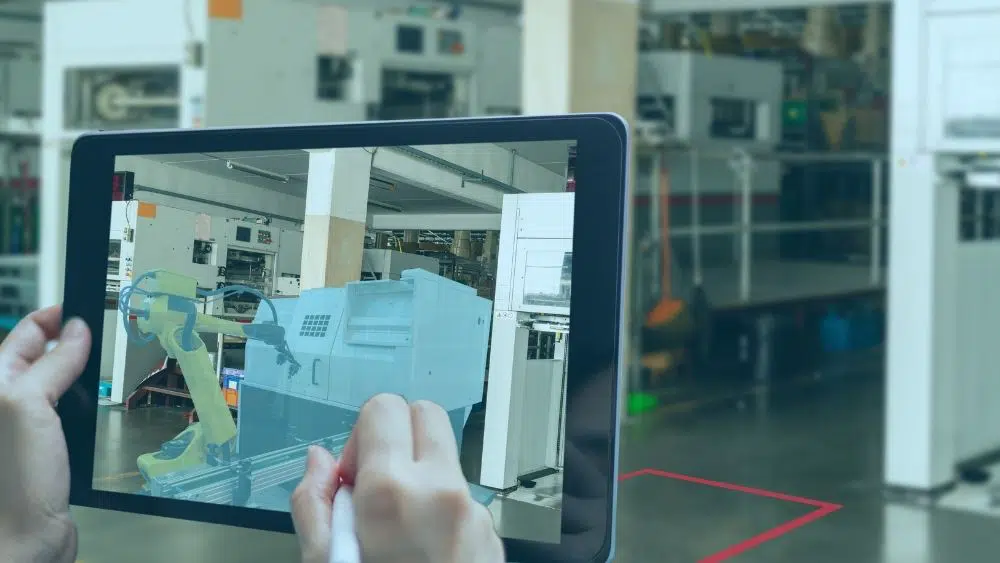In 2022, many realtors were looking for new ways to leverage technology for their business. As web-based apps, contactless payments, electronic contracts, and video conferencing continued to be a critical component of consumer interactions, buyers are seeking easier ways to shop efficiently using a smartphone, computer, or tablet.
When a client decides to buy a new home, they naturally want to view multiple properties and weigh their options before choosing the perfect one. This process is inherently time-consuming for both the buyer and the realtor. New home buyers can use virtual reality to view multiple listings, trim down their shortlist for in-person showings, and make the most of everyone’s time by visiting homes that truly spark their interest. Virtual reality provides an alternative to traveling from site to site by giving potential buyers an interactive platform to view multiple properties from any location. When traveling to see the property in person is not feasible, interested buyers can experience it using technology simulation.
In light of the events of 2020, many realtors have increased their use of virtual technology, especially virtual staging, as a means to conduct business while adhering to social distancing guidelines. The shift to online shopping and work from home has pushed more buyers than ever before to the virtual marketplace. To meet the demands of an emerging generation of tech-savvy buyers, realtors are familiarizing themselves with tools such as augmented reality and virtual reality. VR technology has been prevalent in listings for higher-end homes worth over $20 million, and it has become more widely utilized in the mid-range home market. Learn more about how your business can take advantage of this new trend and gain a professional edge in the market.
Augmented Reality (AR) Vs. Virtual Reality (VR)

Augmented reality and virtual reality are often confused with one another, so it’s helpful to define these terms and explain the difference. Augmented reality involves digital elements overlayed to a live view. Consumers use AR to visualize room personalization via a smartphone camera. Examples include Pokemon Go and Wayfair’s ability to view furniture staged in the buyer’s home from the app.
Virtual reality involves the process of semi- or total immersion of the user. It allows users to move through the home and interact with the virtual environment. Real estate agents can create a 360-degree walkthrough of their clients’ properties. Agents can create a digital tour with a panoramic camera or Matterport iPhone app.
Types of Virtual Reality
There are three main types of virtual reality: non-immersive, semi-immersive, and fully immersive. Non-immersive is the most common in everyday life. It includes a computer-generated environment, but users maintain control and are aware of their physical surroundings. This is like computer gaming; an individual views the virtual world on a screen and controls it with an external device.
Semi-immersive virtual reality includes a partially virtual environment where participants are connected with their physical environment, but might be immersed in 3D graphics. Detailed graphics allow a deeper connection between the user and the virtual world. Fully immersive simulations offer the most realistic experience by allowing people to interact with virtual reality. It requires VR glasses or a head mount display that offer high-resolution and a broader view. The glasses create a 3D effect and allow the user to walk through the designed reality simulation.
Virtual reality owes its popularity to the video gaming and entertainment industry. However, many businesses in the real estate sector are just scratching the surface in finding new ways to utilize VR for professional purposes, such as attracting clients and showing new listings.
Benefits For Realtors

More Showings, Less Travel
Some realtors enjoy the ability to manage a wide variety of property listings by digitizing them. The process of developing a VR simulation can be well worth the time and investment to reach multiple buyers, especially in the case of master-planned communities or condominium-style homes with identical layouts.
One fully-immersive virtual simulation of the property can be shown to multiple potential buyers – even simultaneously. What would normally have taken hours driving from site to site now takes only minutes. Prospective buyers may experience many properties from the comfort of your office and in only one appointment. This saves you, the realtor, precious time and keeps the properties moving!
Personalize Design Touches
Start with one virtual design of the floorplan and dimensions, then add customization options for buyers to browse. This is especially keen for apartment-style living or customizable condos. Clients may walk through the layout and change paint colors, moldings, or floor styles on command. Sometimes the interior design can be a dealbreaker for new home shoppers when they begin viewing. Give them the freedom and opportunity to experience exactly what their home would feel like if they could choose the décor.
Additionally, potential buyers can identify any glaring issues or seize opportunities for optimization. If concerns are spotted early on, buyers can make alterations as needed to ensure their dream home is built to perfection prior to move-in.
Optimal Lighting and Conditions
Showings are conducted in the evenings or early mornings when new home shoppers are not at work. Of course, these are not the optimal times to show a home, as it is often too dark. Weather is also unpredictable, and rain showers or snow days can ruin the mood. Capture the perfect daytime view of the home with ideal lighting and conditions through the virtual reality setup. Sunlight will always be streaming through the windows, filling the gorgeously displayed floorplan.
Less Property Maintenance
You can eliminate those extra steps to clean up after a showing or prep the house for new buyers. By offering virtual simulation, you can save time and money normally spent on cleaning products. Invest your energy into preparing the client’s top three favorite homes for show after they weed out the options.
Reach More Clients
Many potential buyers face limitations at various times in their homeownership journey. Elderly clients may not have reliable transportation to view several homesites. If clients have mobility issues, it may be tiring or stressful to tour multiple homes in a day. Virtual reality offers a new method for delivering beautiful new home experiences to clients with transportation or mobility limitations.
If you’re interested in expanding your business worldwide, consider the possibilities of virtually showing homes to buyers across the globe. Virtual reality offers infinite possibilities for connecting with clients across the globe.
Gain A Professional Edge
Learning to use the latest technology and integrate it into your business plan not only sets you apart from other sellers, helping you tap into a new market of young tech-savvy buyers. By simply marketing yourself with technological proficiency, you will gain a strong professional edge to attract new clients.
More Showings, Less Travel
Some realtors enjoy the ability to manage a wide variety of property listings by digitizing them. The process of developing a VR simulation can be well worth the time and investment to reach multiple buyers, especially in the case of master-planned communities or condominium-style homes with identical layouts.
One fully-immersive virtual simulation of the property can be shown to multiple potential buyers – even simultaneously. What would normally have taken hours driving from site to site now takes only minutes. Prospective buyers may experience many properties from the comfort of your office and in only one appointment. This saves you, the realtor, precious time and keeps the properties moving!
Personalize Design Touches
Start with one virtual design of the floorplan and dimensions, then add customization options for buyers to browse. This is especially keen for apartment-style living or customizable condos. Clients may walk through the layout and change paint colors, moldings, or floor styles on command. Sometimes the interior design can be a dealbreaker for new home shoppers when they begin viewing. Give them the freedom and opportunity to experience exactly what their home would feel like if they could choose the décor.
Additionally, potential buyers can identify any glaring issues or seize opportunities for optimization. If concerns are spotted early on, buyers can make alterations as needed to ensure their dream home is built to perfection prior to move-in.
Optimal Lighting and Conditions
Showings are often conducted in the evenings or early mornings when new home shoppers are not at work. Of course, these are not the optimal times to show a home, as it is often too dark. Weather is also unpredictable, and rain showers or snow days can ruin the mood. Capture the perfect daytime view of the home with ideal lighting and conditions through the virtual reality setup. Sunlight will always be streaming through the windows, filling the gorgeously displayed floorplan.
Less Property Maintenance
You can eliminate those extra steps to clean up after a showing or prep the house for new buyers. By offering virtual simulation, you can save time and money normally spent on cleaning products. Invest your energy into preparing the client’s top three favorite homes for show after they weed out the other options.
Reach More Clients
Many potential buyers face limitations at various times in their homeownership journey. Elderly clients may not have reliable transportation to view several homesites. If clients have mobility issues, it may be tiring or stressful to tour multiple homes in a day. Virtual reality offers a new method for delivering beautiful new home experiences to clients with transportation or mobility limitations.
If you’re interested in expanding your business worldwide, consider the possibilities of virtually showing homes to buyers across the globe. Virtual reality offers infinite possibilities for connecting with clients across the globe.
Gain A Professional Edge
Learning to use the latest technology and integrate it into your business plan not only sets you apart from other sellers, it helps you tap into a new market of young tech-savvy buyers. By simply marketing yourself with technological proficiency, you will gain a strong professional edge to attract new clients.
Additional Considerations

Familiarize Yourself with The Technology
Before implementing virtual reality options into your business, it is crucial to learn the ins and outs of the technology. Experiment with different settings, cameras, and professional equipment to determine what combination offers the best 360-view.
You also want to decide if you will provide guided or interactive visits. Guided visits simply take the client on a 3D pathway through the property, just like if they were visiting with you, the realtor, in person. Interactive visits allow the clients to choose points of interest to explore in the environment. When you’re familiar with the technology, guided tours may take 1-2 hours to create, while interactive tours will likely take a minimum of 2-4 hours.
Equipment
Potential buyers will need the proper equipment such as a head mount display or VR glasses to access the virtual reality space. You can provide these glasses for clients in the office while you direct them through showings in real-time. If clients do not already have VR gaming glasses, the price may be cost-prohibitive (generally $399-$499). Some real estate pros have purchased less expensive VR glasses to send to clients who live far away. This is also a unique opportunity to add your brand to the headset to promote your business.
Open Space
Be sure that the space where you will set up your VR system is wide open for movement. Users should have plenty of room to move around comfortably without the risk of running into walls or furniture. Always remove excess clutter.
Accommodate More Clients
Think smarter, not harder. Less driving, happier clients, and an expansive portfolio of current homes on the market at your fingertips means an easier and faster path to closing. Virtual reality creates the opportunity for real estate pros to showcase a property, highlight its best-selling points, and close the deal with future buyers. Free up your schedule and close on more homes by choosing VR technology that works for you!


